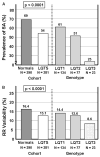The prevalence and diagnostic/prognostic utility of sinus arrhythmia in the evaluation of congenital long QT syndrome
- PMID: 20673812
- PMCID: PMC3332538
- DOI: 10.1016/j.hrthm.2010.07.030
The prevalence and diagnostic/prognostic utility of sinus arrhythmia in the evaluation of congenital long QT syndrome
Abstract
Background: Congenital long QT syndrome (LQTS) affects 1 in 2,500 people and can cause syncope and sudden death. Sinus arrhythmia (SA) is nonpathologic baseline respiratory variation of the RR interval.
Objective: This study sought to determine the frequency of SA and its clinical significance among patients with LQTS.
Methods: We performed an institutional review board-approved retrospective review of all patients (N = 571) evaluated in our LQTS clinic from 7/2000 to 3/2008 diagnosed with LQTS (N = 281) or dismissed as otherwise normal (N = 290). Blinded to diagnosis, the first available electrocardiogram for each patient was examined to quantitate RR interval variability.
Results: Overall, 151 of 281 patients (54%) with LQTS (159 female patients, average age 21.8 ± 16.5 years, average QTc 466 ± 43 ms) had SA with an average RR variability of 13% ± 8% compared with 201 of 290 (69%) patients dismissed as normal (178 female patients, average age 21.7 ± 16 years, average QTc 424 ± 30 ms) who demonstrated SA with RR variability of 16% ± 10% (P < .0001). These differences remained significant when patients on concurrent beta-blocker therapy were excluded (P < .001). SA was least common in LQT3 (23%) compared with LQT1 (61%, P < .005) and LQT2 (51%, P = .055). Patients presenting with torsades de pointes or aborted cardiac arrest had lower RR variability (10% ± 7%, P < .03).
Conclusion: SA frequency and magnitude of RR variability was lower among patients with LQTS compared with those patients dismissed as otherwise normal. This attenuation in RR interval variability remained when patients on beta-blocker therapy were excluded. Although the presence/absence of sinus arrhythmia is of little diagnostic value due to cohort overlap, LQTS patients with negligible RR interval variation may be at higher risk.
Copyright © 2010 Heart Rhythm Society. Published by Elsevier Inc. All rights reserved.
Figures



Similar articles
-
Holter monitoring in the evaluation of congenital long QT syndrome.Pacing Clin Electrophysiol. 2011 Sep;34(9):1100-4. doi: 10.1111/j.1540-8159.2011.03102.x. Epub 2011 Apr 20. Pacing Clin Electrophysiol. 2011. PMID: 21507020
-
Risk of Cardiac Events Associated With Antidepressant Therapy in Patients With Long QT Syndrome.Am J Cardiol. 2018 Jan 15;121(2):182-187. doi: 10.1016/j.amjcard.2017.10.010. Epub 2017 Nov 13. Am J Cardiol. 2018. PMID: 29174490 Free PMC article.
-
Use of Artificial Intelligence and Deep Neural Networks in Evaluation of Patients With Electrocardiographically Concealed Long QT Syndrome From the Surface 12-Lead Electrocardiogram.JAMA Cardiol. 2021 May 1;6(5):532-538. doi: 10.1001/jamacardio.2020.7422. JAMA Cardiol. 2021. PMID: 33566059 Free PMC article.
-
Evaluation and Management of Athletes With Long QT Syndrome.Sports Health. 2016 Nov/Dec;8(6):527-535. doi: 10.1177/1941738116660294. Epub 2016 Aug 6. Sports Health. 2016. PMID: 27480102 Free PMC article. Review.
-
QTc: how long is too long?Br J Sports Med. 2009 Sep;43(9):657-62. doi: 10.1136/bjsm.2008.054734. Br J Sports Med. 2009. PMID: 19734499 Free PMC article. Review.
Cited by
-
Updates on the inherited cardiac ion channelopathies: from cell to clinical.Curr Treat Options Cardiovasc Med. 2012 Oct;14(5):473-89. doi: 10.1007/s11936-012-0198-1. Curr Treat Options Cardiovasc Med. 2012. PMID: 22865245
References
-
- Jervell A, Lange-Nielsen F. Congenital deaf-mutism, functional heart disease with prolongation of the Q-T interval and sudden death. Am Heart J. 1957;54:59–68. - PubMed
-
- Ward OC. A new familial cardiac syndrome in children. J Ir Med Assoc. 1964;54:103–106. - PubMed
-
- Romano C, Gemme G, Pongiglione R. Rare cardiac arrythmias of the pediatric age. II. Syncopal attacks due to paroxysmal ventricular fibrillation (Presentation of 1st case in Italian pediatric literature) Clin Pediatr (Bologna) 1963;45:656–683. - PubMed
-
- Stramba-Badiale M, Crotti L, Goulene K, et al. Electrocardiographic and genetic screening for long QT syndrome: results from a prospective study on 44,596 neonates. Circulation. 2007;116:II_377.
-
- Moss AJ. Long QT syndrome. JAMA. 2003;289:2041–2044. - PubMed
Publication types
MeSH terms
Grants and funding
LinkOut - more resources
Full Text Sources
Medical

